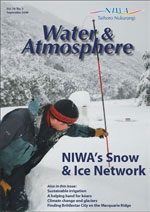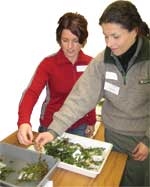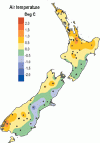PDF of this article (91 KB)

Stratospheric ozone recovery
The Montreal Protocol has been very successful is reducing emissions of man-made ozone-depleting substances to the atmosphere. In response, stratospheric concentrations of halogens (chlorine and bromine) that deplete ozone are declining, and ozone is expected to return to pre-1980 levels during this century. With this in mind, the 2006 WMO/UNEP scientific assessment of ozone depletion included a chapter focusing on ozone recovery, the first such chapter since the assessments began.
To provide a robust framework for the discussion of ozone recovery in the forthcoming ozone assessment, Greg Bodeker (NIWA) and Darryn Waugh (Johns Hopkins University), the two lead authors of the ozone recovery chapter in the 2006 assessment, convened a workshop in Boulder, Colorado, in May. The two-day workshop, attended by 16 international experts on stratospheric ozone recovery, aimed to identify some of the issues involved with defining and quantifying ozone recovery, to discuss the appropriateness, advantages, disadvantages, and science behind different approaches, and to formulate a consensus on the best way to present ozone recovery.
The main outcome from the workshop is a new framework that bases the discussion of ozone recovery on answeringtwo questions: ”Has the Montreal Protocol been successful?” and ”How do we expect ozone will evolve in the future?”. A paper summarising the new framework will be submitted to the Bulletin of the American Meteorological Society. The next WMO/UNEP scientific assessment will be published in 2010.
For futher information, contact: Dr Greg Bodeker, 0-3-440 0438, [email protected]
Getting to grips with pest plants

In August, NIWA hosted 30 keen regional council and Department of Conservation (DOC) staff for a one-day MAF Biosecurity New Zealand workshop about the National Pest Plant Accord.
The NPPA is a cooperative agreement between the Nursery and Garden Industry Association, regional councils, MAF Biosecurity New Zealand, and DOC. It prevents the sale, propagation, or distribution across the country of over 100 species, including 30 aquatic plants. Regional councils undertake surveillance to prevent the commercial sale and/or distribution of these plants.
Based at NIWA’s Hamilton campus, the workshop focused on aquatic plants, with an identification session run by Paul Champion and Kerry Bodmin and a bus trip to to Ruakura to look at the NIWA experimental facility and the AgResearch quarantine glasshouse. The remainder of the afternoon was spent discussing legal requirements of plant nursery/aquarium inspections and identification of new terrestrial plants added to the list this year.
For further information, contact: Paul Champion, 0-7-856 6796, [email protected]
NIWA Science & Technology Fairs

It’s that time again: from late August to October, NIWA is sponsoring five of the nation’s regional Science & Technology Fairs. For hundreds of students from Year 7 to Year 13, the fairs are the culmination of months spent on projects ranging from the antibacterial properties of dog saliva to biofuels as alternative energy sources.
Prizes are donated by a range of businesses and science organisations. In addition to a cash prize, the overall winner at each of the regional events will be nominated for a place at Genesis Energy’s ‘Realise the Dream’, a week-long festival of events for young scientists, technologists, and others, to be held in Wellington in December. Some students will also be eligible for the ‘Hands on Science’ week, held at Otago University in January 2009.
“NIWA is proud to again sponsor this event as part of our long-term commitment to enhancing science and technology for young New Zealanders,” says NIWA’s Education Coordinator,Dr Julie Hall. “Participation in Science and Technology Fairs is on its own a powerful learning tool and should also be fun. The enthusiasm of the participants in researching, constructing, and presenting their exhibits is plain to see. And we hope that many of the students exhibiting at this year’s fairs will take up careers in science, which are vital to sustaining New Zealand’s economy and environment.”
The NIWA-sponsored fairs this year:
- Wellington: 20–23 August
- Bay of Plenty: 28–29 August
- Waikato: 28–29 August
- Nelson: 17 September
- Auckland: 20–23 October
For further information, contact: Tracey Edwards, 0-7-859 1852, [email protected]
